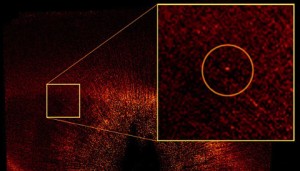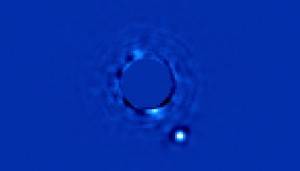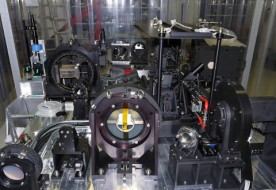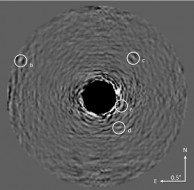Exoplanet missions are shifting their goals from counting to characterizing, with multiple instruments coming online to directly image these alien worlds.
| Update: Astronomers have announced the results from SPHERE's first light observing run, during which several objects were targeted. These include images of Saturn's moon Titan, and various dust rings around nearby stars. For more details see ESO's press release. |

NASA / ESA
Exoplanets are unquestionably a hot topic, regularly making the headlines even in popular media. But it’s amazing how little we actually know about these alien worlds, save for their distances from their host stars, their radii, and — if we’re lucky — their masses.
For more than 20 years, astronomers have worked diligently to infer the presence of exoplanets by the effects they have on their parent stars. Among other things, they might look for a star’s signature dimming due to a transiting exoplanet, or for the star’s wobble induced by an exoplanet’s gravitational tug.
The results trickled in at first, but the numbers grew exponentially as technology and search techniques evolved. Now missions are shifting their goals from counting to characterizing and even imaging these alien worlds.
Disentangling a faint, barely reflective, exoplanet from its overwhelmingly bright star in a direct image proves quite the challenge. Even young planets that retain the heat of their formation glow only faintly in the infrared. Nonetheless, several new missions are going online to pry these exoplanets out of the shadows.
“Direct imaging is a very useful compliment [to previous methods],” says Bruce Macintosh (Stanford University). “When you image a planet, you can almost always characterize it with spectroscopy — determining its temperature, getting some evidence about its composition, gravity, and perhaps formation history.”
Let’s take a detailed look at some of the exciting planet imagers coming online.
Gemini Planet Imager
In November 2013, Macintosh’s team saw first light with a new instrument — the Gemini Planet Imager (GPI) — attached to one of the most powerful telescopes in the world, the Gemini South Telescope in Chile. Not only can this instrument resolve the dim light from the exoplanet but it can also analyze the planet’s atmosphere, including its temperature and composition.
GPI can see exoplanets 10 million times fainter than their parent stars at separations as small as 0.2 arcsecond. It will detect exoplanets from 4 to 40 astronomical units (a.u.), says James Graham (University of California, Berkeley), GPI’s chief scientist. This will further extend exoplanet inventories, which are only complete within 5 a.u.
To obtain those impressive stats, GPI covers the parent star with a coronagraph, which blocks most of its glaring light while next-generation adaptive optics correct for the blurring effects of turbulence in Earth’s atmosphere. More than 4,000 silicon microchips bend a deformable mirror to respond to the turbulence measured and provide a clear image of the exoplanet.

Christian Marois / NRC Canada.
Already, GPI has targeted the well-known Beta Pictoris system, where the giant exoplanet Beta Pictoris b orbits its host star from a distance 25% greater than Saturn’s orbit around the Sun. The research team imaged the planet in only 60 seconds, whereas previous observations took at least an hour.
The image pinned down the planet’s orbit, showing that the planet has passed its maximum distance from its host star and is now headed back toward it. In fact, there’s a very small chance (about 4%) that Beta Pic b might actually transit its host star in 2017.
Beta Pic b made for an easy first target; this year, the GPI team will begin a survey of 600 young stars, searching for and characterizing the giant planets in orbit. GPI will also study dusty, planet-forming disks and winds from massive stars.
SPHERE
GPI’s European counterpart — the Spectro-Polarimetric High-contrast Exoplanet REsearch (SPHERE) instrument on the Very Large Telescope (VLT) in Chile — came online just this month, and the release of first-light images is imminent.

SPHERE Project / ESO / J.-L. Beuzit
SPHERE complements GPI well, Macintosh says. Their main instruments cover the same wavelength range and both use the same next-gen adaptive optics technology. But SPHERE is slightly more versatile with additional instruments that extend its capabilities. For example, while GPI works only in the infrared, SPHERE has an additional visible-light polarimeter, which obtains the polarization — the light waves’ preferred plane of vibration — from 600 to 900 nanometers, allowing astronomers to better understand any dusty planet-forming disks.
SPHERE saw first light on May 8th in an observing run that finished on May 21st.
“The instrument is performing exceptionally well, and we already took spectacular images,” says Ralf Siebenmorgen, chair of SPHERE’s instrument science and operation team. Those images are currently under wraps, but keep your eyes peeled — we’ll let you know when they’re released.
Bundles of Planet Imagers
But the fleet of planet imagers doesn’t end there.

Project 1640
Project 1640 — an imaging system at the Palomar 5-m Hale telescope that began training its eye on exoplanets in early 2013 — is already surveying about 200 stars, looking for planets and brown dwarfs. While the instrument is on a much smaller telescope and has the disadvantage of being located in the northern hemisphere (the youngest stars closest to the Sun tend to be in the southern hemisphere), Project 1640 nonetheless provided the world with the first spectrum of all four known planets around HR 8799.
A fourth project yet to come online is the Subaru Telescope Extreme Adaptive Optics (SCExAO) instrument. SCExAO will image planets at smaller separations, between 40 and 500 milli-arcseconds — at best five times smaller than GPI’s capabilities.
It’s designed to be very flexible, so the team can “try out the newest and fanciest technology,” Macintosh says, unlike GPI, which had to ‘freeze’ its technology five years ago to go through approval as a Gemini instrument.
As of today a few dozen planets have been imaged directly, but the instruments are still in their infancy and their potential is bright.
“In the future, with such methods, it could be possible to detect spectroscopic signatures of life,” says exoplanet expert Anne-M. Lagrange (Observatoire de Grenoble Laboratoire d'Astrophysique).
 1
1









Comments
May 28, 2014 at 12:19 pm
Is there any plans to work with NASA to use The Stratospheric Observatory for Infrared Astronomy ( SOFIA) to look at these Exoplanets for validation?
You must be logged in to post a comment.
You must be logged in to post a comment.